Analyzing Online Privacy and Security Issues Using Ethical Theories
VerifiedAdded on 2023/06/12
|7
|1684
|55
Essay
AI Summary
This essay explores the multifaceted issues surrounding online privacy and security in the digital age, where e-commerce and online interactions have become increasingly prevalent. It identifies common threats such as the proliferation of cookies, location data tracking, control of personal information, and identity theft, all exacerbated by the ease with which companies can collect and potentially misuse consumer data. The essay then delves into potential solutions, including limiting data collection, providing privacy features, and employing cookies with shorter timelines. By analyzing these issues through the lens of four classical ethical theories—utilitarianism, deontology, virtue ethics, and contract theory—the essay aims to provide a well-reasoned justification for its recommendations, ultimately advocating for a balanced approach that protects consumer rights while fostering innovation. Desklib offers this essay as a resource for students studying law and ethics, providing a comprehensive analysis and a valuable reference for further research.
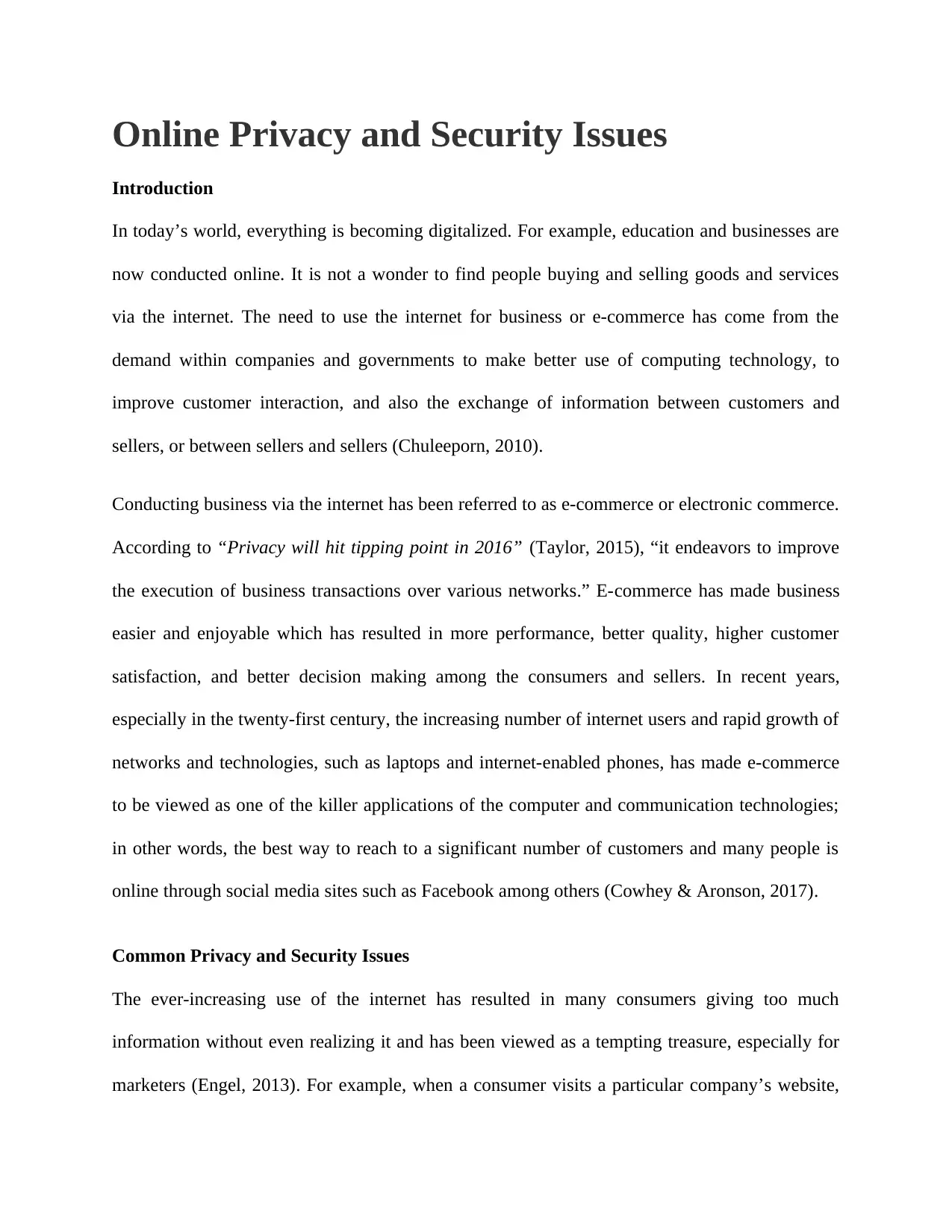
Online Privacy and Security Issues
Introduction
In today’s world, everything is becoming digitalized. For example, education and businesses are
now conducted online. It is not a wonder to find people buying and selling goods and services
via the internet. The need to use the internet for business or e-commerce has come from the
demand within companies and governments to make better use of computing technology, to
improve customer interaction, and also the exchange of information between customers and
sellers, or between sellers and sellers (Chuleeporn, 2010).
Conducting business via the internet has been referred to as e-commerce or electronic commerce.
According to “Privacy will hit tipping point in 2016” (Taylor, 2015), “it endeavors to improve
the execution of business transactions over various networks.” E-commerce has made business
easier and enjoyable which has resulted in more performance, better quality, higher customer
satisfaction, and better decision making among the consumers and sellers. In recent years,
especially in the twenty-first century, the increasing number of internet users and rapid growth of
networks and technologies, such as laptops and internet-enabled phones, has made e-commerce
to be viewed as one of the killer applications of the computer and communication technologies;
in other words, the best way to reach to a significant number of customers and many people is
online through social media sites such as Facebook among others (Cowhey & Aronson, 2017).
Common Privacy and Security Issues
The ever-increasing use of the internet has resulted in many consumers giving too much
information without even realizing it and has been viewed as a tempting treasure, especially for
marketers (Engel, 2013). For example, when a consumer visits a particular company’s website,
Introduction
In today’s world, everything is becoming digitalized. For example, education and businesses are
now conducted online. It is not a wonder to find people buying and selling goods and services
via the internet. The need to use the internet for business or e-commerce has come from the
demand within companies and governments to make better use of computing technology, to
improve customer interaction, and also the exchange of information between customers and
sellers, or between sellers and sellers (Chuleeporn, 2010).
Conducting business via the internet has been referred to as e-commerce or electronic commerce.
According to “Privacy will hit tipping point in 2016” (Taylor, 2015), “it endeavors to improve
the execution of business transactions over various networks.” E-commerce has made business
easier and enjoyable which has resulted in more performance, better quality, higher customer
satisfaction, and better decision making among the consumers and sellers. In recent years,
especially in the twenty-first century, the increasing number of internet users and rapid growth of
networks and technologies, such as laptops and internet-enabled phones, has made e-commerce
to be viewed as one of the killer applications of the computer and communication technologies;
in other words, the best way to reach to a significant number of customers and many people is
online through social media sites such as Facebook among others (Cowhey & Aronson, 2017).
Common Privacy and Security Issues
The ever-increasing use of the internet has resulted in many consumers giving too much
information without even realizing it and has been viewed as a tempting treasure, especially for
marketers (Engel, 2013). For example, when a consumer visits a particular company’s website,
Paraphrase This Document
Need a fresh take? Get an instant paraphrase of this document with our AI Paraphraser
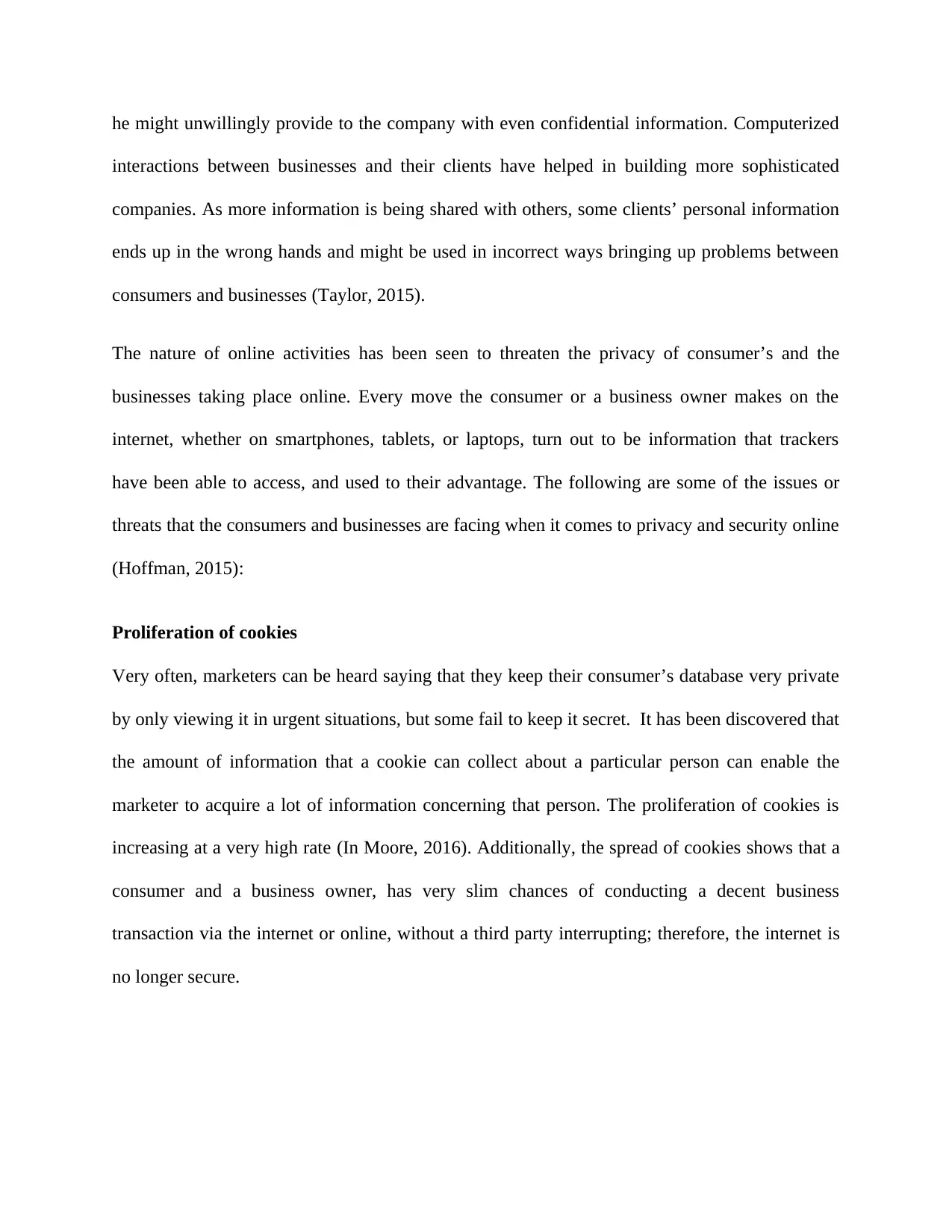
he might unwillingly provide to the company with even confidential information. Computerized
interactions between businesses and their clients have helped in building more sophisticated
companies. As more information is being shared with others, some clients’ personal information
ends up in the wrong hands and might be used in incorrect ways bringing up problems between
consumers and businesses (Taylor, 2015).
The nature of online activities has been seen to threaten the privacy of consumer’s and the
businesses taking place online. Every move the consumer or a business owner makes on the
internet, whether on smartphones, tablets, or laptops, turn out to be information that trackers
have been able to access, and used to their advantage. The following are some of the issues or
threats that the consumers and businesses are facing when it comes to privacy and security online
(Hoffman, 2015):
Proliferation of cookies
Very often, marketers can be heard saying that they keep their consumer’s database very private
by only viewing it in urgent situations, but some fail to keep it secret. It has been discovered that
the amount of information that a cookie can collect about a particular person can enable the
marketer to acquire a lot of information concerning that person. The proliferation of cookies is
increasing at a very high rate (In Moore, 2016). Additionally, the spread of cookies shows that a
consumer and a business owner, has very slim chances of conducting a decent business
transaction via the internet or online, without a third party interrupting; therefore, the internet is
no longer secure.
interactions between businesses and their clients have helped in building more sophisticated
companies. As more information is being shared with others, some clients’ personal information
ends up in the wrong hands and might be used in incorrect ways bringing up problems between
consumers and businesses (Taylor, 2015).
The nature of online activities has been seen to threaten the privacy of consumer’s and the
businesses taking place online. Every move the consumer or a business owner makes on the
internet, whether on smartphones, tablets, or laptops, turn out to be information that trackers
have been able to access, and used to their advantage. The following are some of the issues or
threats that the consumers and businesses are facing when it comes to privacy and security online
(Hoffman, 2015):
Proliferation of cookies
Very often, marketers can be heard saying that they keep their consumer’s database very private
by only viewing it in urgent situations, but some fail to keep it secret. It has been discovered that
the amount of information that a cookie can collect about a particular person can enable the
marketer to acquire a lot of information concerning that person. The proliferation of cookies is
increasing at a very high rate (In Moore, 2016). Additionally, the spread of cookies shows that a
consumer and a business owner, has very slim chances of conducting a decent business
transaction via the internet or online, without a third party interrupting; therefore, the internet is
no longer secure.
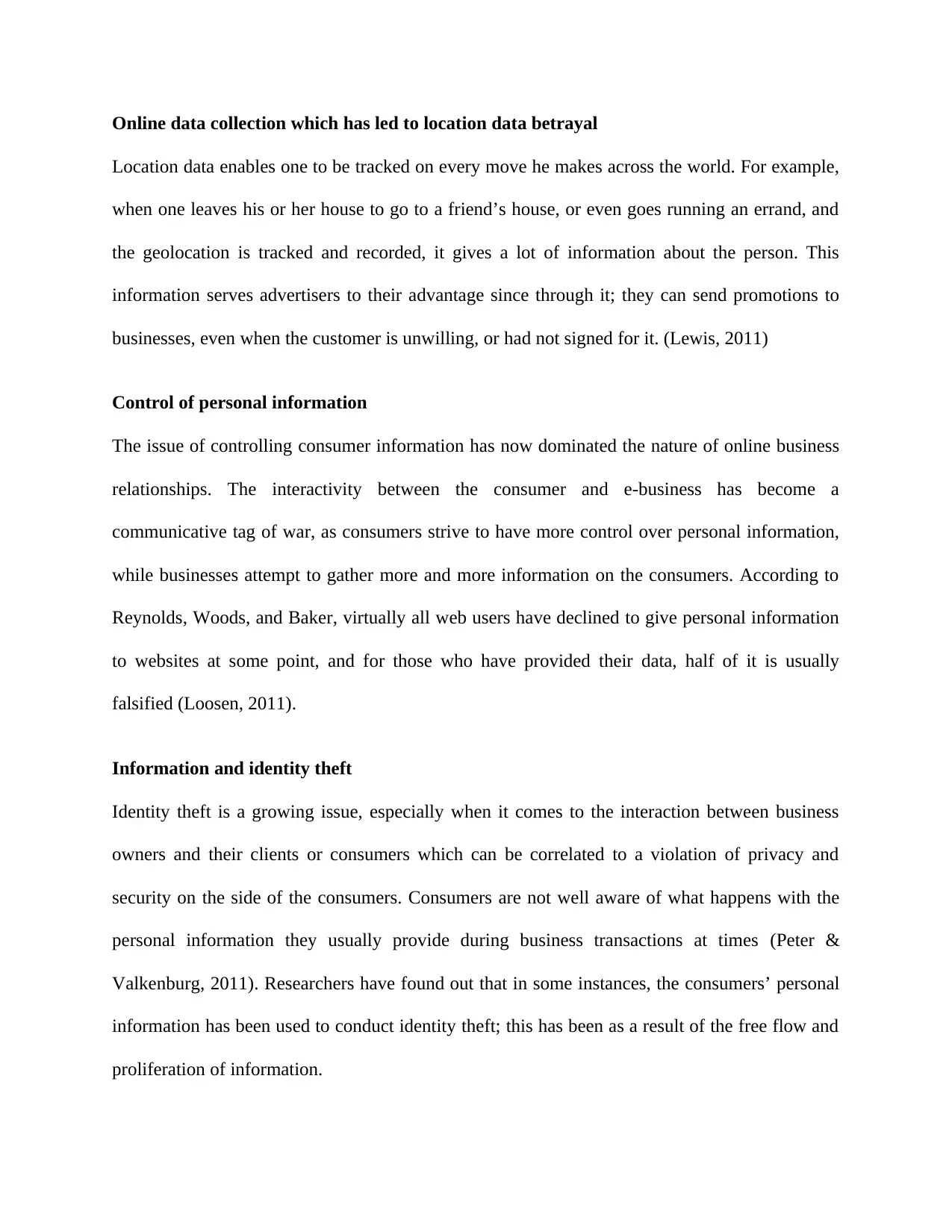
Online data collection which has led to location data betrayal
Location data enables one to be tracked on every move he makes across the world. For example,
when one leaves his or her house to go to a friend’s house, or even goes running an errand, and
the geolocation is tracked and recorded, it gives a lot of information about the person. This
information serves advertisers to their advantage since through it; they can send promotions to
businesses, even when the customer is unwilling, or had not signed for it. (Lewis, 2011)
Control of personal information
The issue of controlling consumer information has now dominated the nature of online business
relationships. The interactivity between the consumer and e-business has become a
communicative tag of war, as consumers strive to have more control over personal information,
while businesses attempt to gather more and more information on the consumers. According to
Reynolds, Woods, and Baker, virtually all web users have declined to give personal information
to websites at some point, and for those who have provided their data, half of it is usually
falsified (Loosen, 2011).
Information and identity theft
Identity theft is a growing issue, especially when it comes to the interaction between business
owners and their clients or consumers which can be correlated to a violation of privacy and
security on the side of the consumers. Consumers are not well aware of what happens with the
personal information they usually provide during business transactions at times (Peter &
Valkenburg, 2011). Researchers have found out that in some instances, the consumers’ personal
information has been used to conduct identity theft; this has been as a result of the free flow and
proliferation of information.
Location data enables one to be tracked on every move he makes across the world. For example,
when one leaves his or her house to go to a friend’s house, or even goes running an errand, and
the geolocation is tracked and recorded, it gives a lot of information about the person. This
information serves advertisers to their advantage since through it; they can send promotions to
businesses, even when the customer is unwilling, or had not signed for it. (Lewis, 2011)
Control of personal information
The issue of controlling consumer information has now dominated the nature of online business
relationships. The interactivity between the consumer and e-business has become a
communicative tag of war, as consumers strive to have more control over personal information,
while businesses attempt to gather more and more information on the consumers. According to
Reynolds, Woods, and Baker, virtually all web users have declined to give personal information
to websites at some point, and for those who have provided their data, half of it is usually
falsified (Loosen, 2011).
Information and identity theft
Identity theft is a growing issue, especially when it comes to the interaction between business
owners and their clients or consumers which can be correlated to a violation of privacy and
security on the side of the consumers. Consumers are not well aware of what happens with the
personal information they usually provide during business transactions at times (Peter &
Valkenburg, 2011). Researchers have found out that in some instances, the consumers’ personal
information has been used to conduct identity theft; this has been as a result of the free flow and
proliferation of information.
⊘ This is a preview!⊘
Do you want full access?
Subscribe today to unlock all pages.

Trusted by 1+ million students worldwide
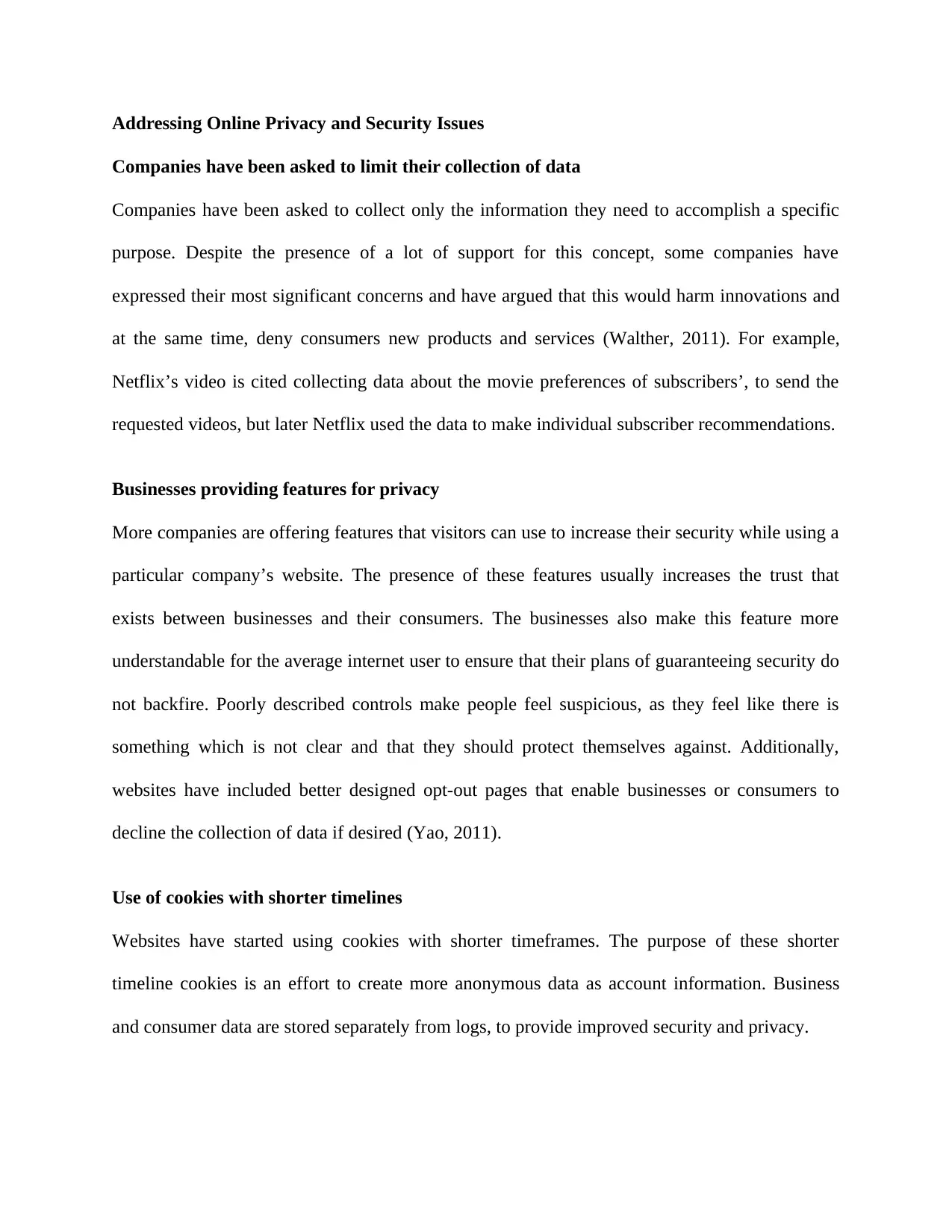
Addressing Online Privacy and Security Issues
Companies have been asked to limit their collection of data
Companies have been asked to collect only the information they need to accomplish a specific
purpose. Despite the presence of a lot of support for this concept, some companies have
expressed their most significant concerns and have argued that this would harm innovations and
at the same time, deny consumers new products and services (Walther, 2011). For example,
Netflix’s video is cited collecting data about the movie preferences of subscribers’, to send the
requested videos, but later Netflix used the data to make individual subscriber recommendations.
Businesses providing features for privacy
More companies are offering features that visitors can use to increase their security while using a
particular company’s website. The presence of these features usually increases the trust that
exists between businesses and their consumers. The businesses also make this feature more
understandable for the average internet user to ensure that their plans of guaranteeing security do
not backfire. Poorly described controls make people feel suspicious, as they feel like there is
something which is not clear and that they should protect themselves against. Additionally,
websites have included better designed opt-out pages that enable businesses or consumers to
decline the collection of data if desired (Yao, 2011).
Use of cookies with shorter timelines
Websites have started using cookies with shorter timeframes. The purpose of these shorter
timeline cookies is an effort to create more anonymous data as account information. Business
and consumer data are stored separately from logs, to provide improved security and privacy.
Companies have been asked to limit their collection of data
Companies have been asked to collect only the information they need to accomplish a specific
purpose. Despite the presence of a lot of support for this concept, some companies have
expressed their most significant concerns and have argued that this would harm innovations and
at the same time, deny consumers new products and services (Walther, 2011). For example,
Netflix’s video is cited collecting data about the movie preferences of subscribers’, to send the
requested videos, but later Netflix used the data to make individual subscriber recommendations.
Businesses providing features for privacy
More companies are offering features that visitors can use to increase their security while using a
particular company’s website. The presence of these features usually increases the trust that
exists between businesses and their consumers. The businesses also make this feature more
understandable for the average internet user to ensure that their plans of guaranteeing security do
not backfire. Poorly described controls make people feel suspicious, as they feel like there is
something which is not clear and that they should protect themselves against. Additionally,
websites have included better designed opt-out pages that enable businesses or consumers to
decline the collection of data if desired (Yao, 2011).
Use of cookies with shorter timelines
Websites have started using cookies with shorter timeframes. The purpose of these shorter
timeline cookies is an effort to create more anonymous data as account information. Business
and consumer data are stored separately from logs, to provide improved security and privacy.
Paraphrase This Document
Need a fresh take? Get an instant paraphrase of this document with our AI Paraphraser
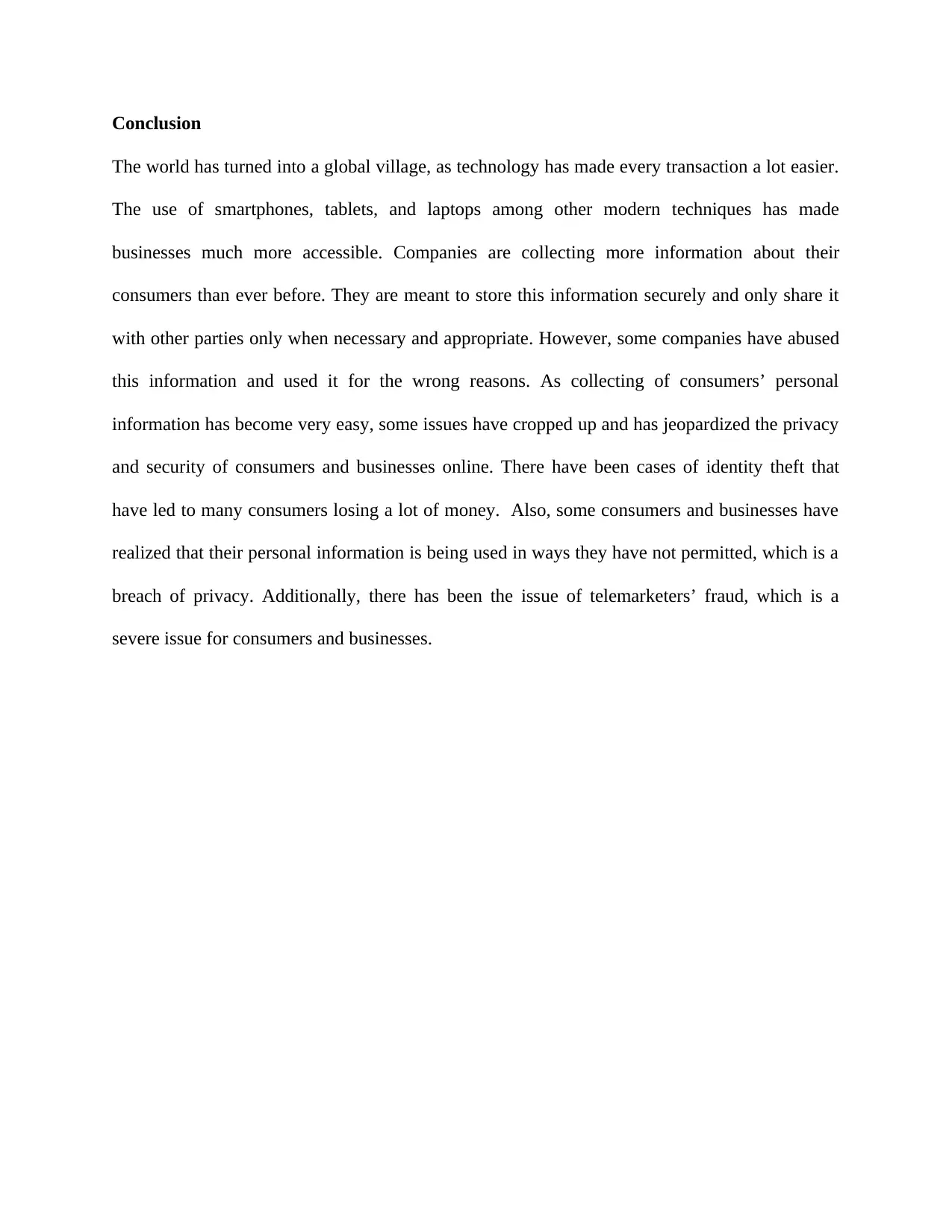
Conclusion
The world has turned into a global village, as technology has made every transaction a lot easier.
The use of smartphones, tablets, and laptops among other modern techniques has made
businesses much more accessible. Companies are collecting more information about their
consumers than ever before. They are meant to store this information securely and only share it
with other parties only when necessary and appropriate. However, some companies have abused
this information and used it for the wrong reasons. As collecting of consumers’ personal
information has become very easy, some issues have cropped up and has jeopardized the privacy
and security of consumers and businesses online. There have been cases of identity theft that
have led to many consumers losing a lot of money. Also, some consumers and businesses have
realized that their personal information is being used in ways they have not permitted, which is a
breach of privacy. Additionally, there has been the issue of telemarketers’ fraud, which is a
severe issue for consumers and businesses.
The world has turned into a global village, as technology has made every transaction a lot easier.
The use of smartphones, tablets, and laptops among other modern techniques has made
businesses much more accessible. Companies are collecting more information about their
consumers than ever before. They are meant to store this information securely and only share it
with other parties only when necessary and appropriate. However, some companies have abused
this information and used it for the wrong reasons. As collecting of consumers’ personal
information has become very easy, some issues have cropped up and has jeopardized the privacy
and security of consumers and businesses online. There have been cases of identity theft that
have led to many consumers losing a lot of money. Also, some consumers and businesses have
realized that their personal information is being used in ways they have not permitted, which is a
breach of privacy. Additionally, there has been the issue of telemarketers’ fraud, which is a
severe issue for consumers and businesses.
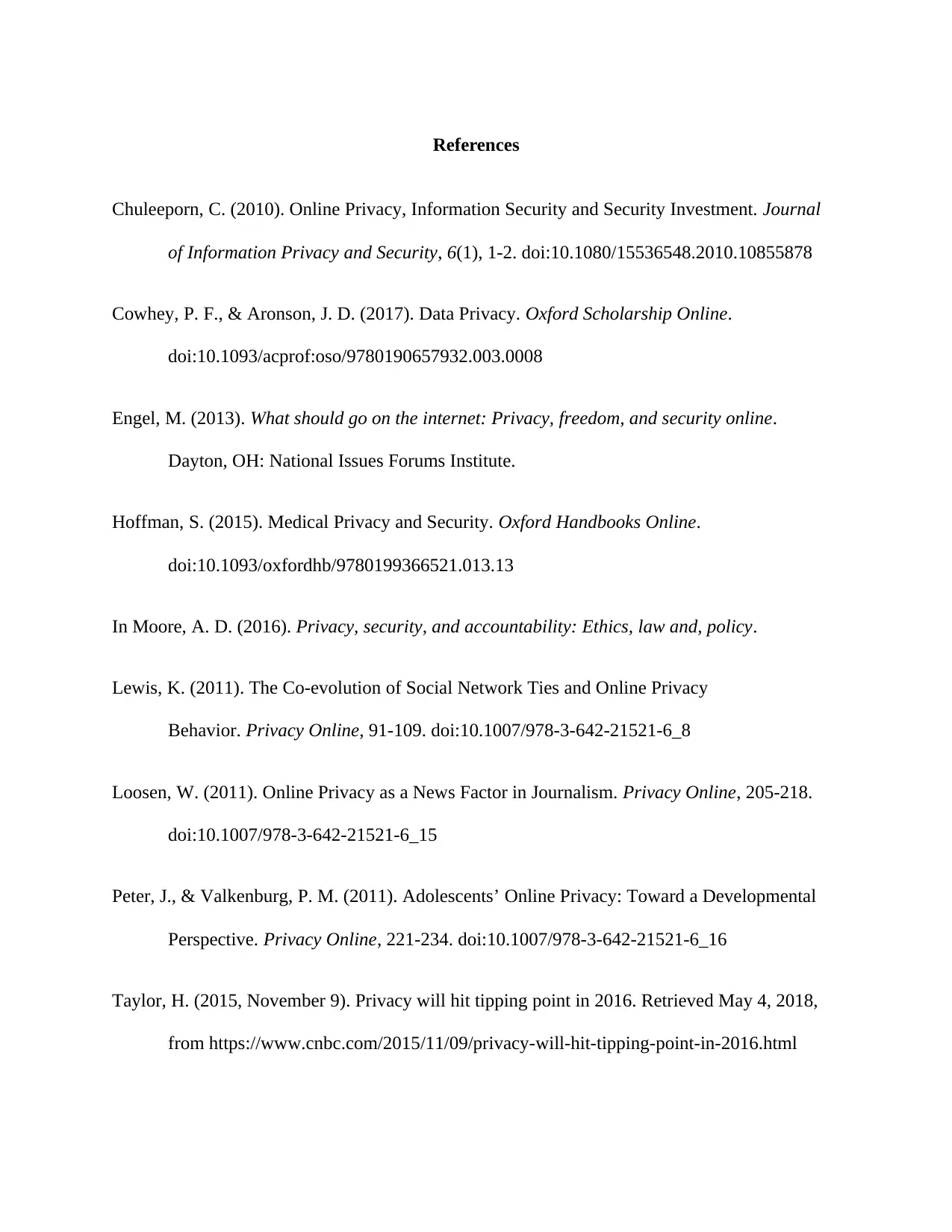
References
Chuleeporn, C. (2010). Online Privacy, Information Security and Security Investment. Journal
of Information Privacy and Security, 6(1), 1-2. doi:10.1080/15536548.2010.10855878
Cowhey, P. F., & Aronson, J. D. (2017). Data Privacy. Oxford Scholarship Online.
doi:10.1093/acprof:oso/9780190657932.003.0008
Engel, M. (2013). What should go on the internet: Privacy, freedom, and security online.
Dayton, OH: National Issues Forums Institute.
Hoffman, S. (2015). Medical Privacy and Security. Oxford Handbooks Online.
doi:10.1093/oxfordhb/9780199366521.013.13
In Moore, A. D. (2016). Privacy, security, and accountability: Ethics, law and, policy.
Lewis, K. (2011). The Co-evolution of Social Network Ties and Online Privacy
Behavior. Privacy Online, 91-109. doi:10.1007/978-3-642-21521-6_8
Loosen, W. (2011). Online Privacy as a News Factor in Journalism. Privacy Online, 205-218.
doi:10.1007/978-3-642-21521-6_15
Peter, J., & Valkenburg, P. M. (2011). Adolescents’ Online Privacy: Toward a Developmental
Perspective. Privacy Online, 221-234. doi:10.1007/978-3-642-21521-6_16
Taylor, H. (2015, November 9). Privacy will hit tipping point in 2016. Retrieved May 4, 2018,
from https://www.cnbc.com/2015/11/09/privacy-will-hit-tipping-point-in-2016.html
Chuleeporn, C. (2010). Online Privacy, Information Security and Security Investment. Journal
of Information Privacy and Security, 6(1), 1-2. doi:10.1080/15536548.2010.10855878
Cowhey, P. F., & Aronson, J. D. (2017). Data Privacy. Oxford Scholarship Online.
doi:10.1093/acprof:oso/9780190657932.003.0008
Engel, M. (2013). What should go on the internet: Privacy, freedom, and security online.
Dayton, OH: National Issues Forums Institute.
Hoffman, S. (2015). Medical Privacy and Security. Oxford Handbooks Online.
doi:10.1093/oxfordhb/9780199366521.013.13
In Moore, A. D. (2016). Privacy, security, and accountability: Ethics, law and, policy.
Lewis, K. (2011). The Co-evolution of Social Network Ties and Online Privacy
Behavior. Privacy Online, 91-109. doi:10.1007/978-3-642-21521-6_8
Loosen, W. (2011). Online Privacy as a News Factor in Journalism. Privacy Online, 205-218.
doi:10.1007/978-3-642-21521-6_15
Peter, J., & Valkenburg, P. M. (2011). Adolescents’ Online Privacy: Toward a Developmental
Perspective. Privacy Online, 221-234. doi:10.1007/978-3-642-21521-6_16
Taylor, H. (2015, November 9). Privacy will hit tipping point in 2016. Retrieved May 4, 2018,
from https://www.cnbc.com/2015/11/09/privacy-will-hit-tipping-point-in-2016.html
⊘ This is a preview!⊘
Do you want full access?
Subscribe today to unlock all pages.

Trusted by 1+ million students worldwide
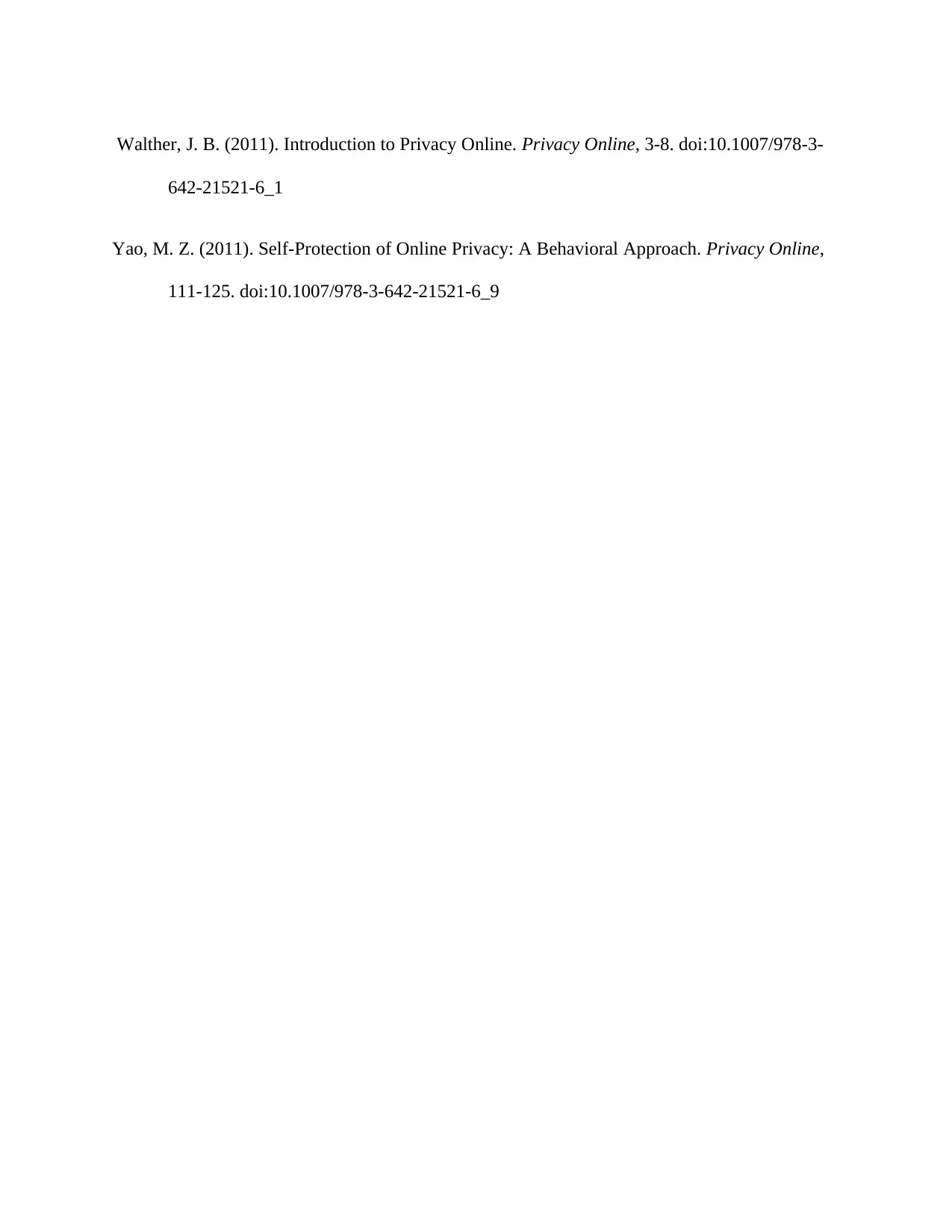
Walther, J. B. (2011). Introduction to Privacy Online. Privacy Online, 3-8. doi:10.1007/978-3-
642-21521-6_1
Yao, M. Z. (2011). Self-Protection of Online Privacy: A Behavioral Approach. Privacy Online,
111-125. doi:10.1007/978-3-642-21521-6_9
642-21521-6_1
Yao, M. Z. (2011). Self-Protection of Online Privacy: A Behavioral Approach. Privacy Online,
111-125. doi:10.1007/978-3-642-21521-6_9
1 out of 7
Related Documents
Your All-in-One AI-Powered Toolkit for Academic Success.
+13062052269
info@desklib.com
Available 24*7 on WhatsApp / Email
![[object Object]](/_next/static/media/star-bottom.7253800d.svg)
Unlock your academic potential
Copyright © 2020–2025 A2Z Services. All Rights Reserved. Developed and managed by ZUCOL.





